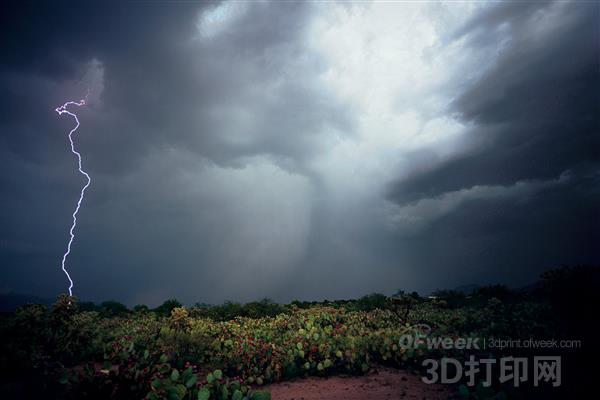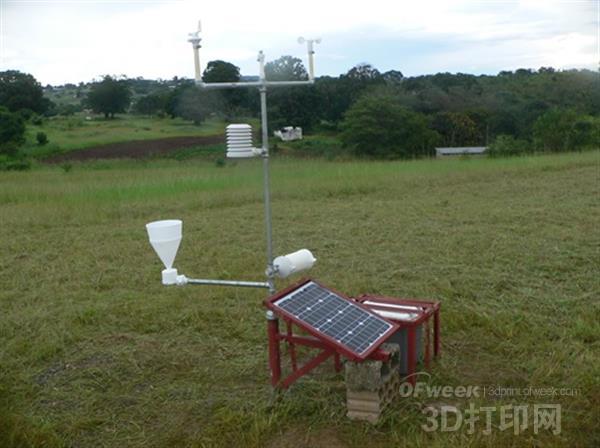A few days ago, scientists have installed the first five low-cost weather stations in Zambia to provide local farmers and other residents with much-needed weather, temperature, rainfall and wind information. These meteorological information and predictions above can help local farmers decide when to grow crops, when to fertilize, and also to warn of floods and other possible disasters.
It is understood that most of the parts of these weather stations are 3D printed so that they can be easily replaced if they are damaged in the field. These weather stations were produced by meteorologists from the National Center for Atmospheric Research (NCAR) and its governing entity, the University of Atmospheric Research (UCAR).

A new weather station near the Chikankata School of Biomedical Sciences in Zambia. On the left is a special rain gauge (with funnel); the circular cylinder in the middle of the vertical pole of the weather station is the radiation shield, inside which is the temperature, humidity and pressure sensor; the other horizontally placed cylinder is equipped with a single board computer. .

At the top is the wind vane (left), solar light sensor (middle) and three cups of wind speed
It is understood that scientists will explore the installation of such low-cost weather stations in other developing countries in need. The project was funded by the US Agency for International Development (AID) Foreign Disaster Assistance Office and the National Weather Service.
“The 3D printing technology here will help save lives,†said SIDin Tokar, a hydrometeorologist at AID. “They can not only provide these countries with the ability to monitor weather-related disasters more accurately, but the data they generate can also help reduce The economic impact of disasters."

Like many developing countries, Zambia does not have the ability to predict the weather in detail, in part because of the scarcity of weather stations. The current density of weather stations in Africa is less than 1/8 of the recommended standards of the World Meteorological Organization. For developing countries, building a weather forecasting network is expensive: the cost of a commercial weather station is typically $10,000 to $20,000, not to mention the cost of routine maintenance and replacement of damaged parts.
In order to solve this problem, UCAR and NCAR scientists have finally developed a weather station that is cheap and easy to repair and can adapt to the needs of the host country. This weather station mainly uses customized plastic parts that can be made with 3D printers . It also uses off-the-shelf sensors on the market, as well as a credit card-sized basic computer developed for students.
The final total cost is: $300 per weather station. Most importantly, the host country can easily print out the parts that need to be replaced in 3D. "Our goal is to make this as easy as possible. It is designed entirely as an open source project," said Martin Steinson, co-head of the project.
In cooperation with Zambia's meteorological department and other agencies, the project team installed the first 3D printed weather stations earlier this year – three of which were installed next to the radio station to broadcast information to the local area, one in the countryside The hospital, and one is adjacent to the headquarters of the country's meteorological department. It is understood that the country's meteorological department will take over the project later this year, with the goal of building a network of 100 weather stations across Zambia. They will also have 3D printers, materials, and training to maintain or upgrade the network.
At present, local meteorologists can use the measurement data of the weather station, and at the same time, the data will be transmitted to NCAR in real time through the wireless network. After all weather stations have been installed, scientists will use NCAR's Meteorological Research and Prediction (WRF) computer model to develop a one- to three-day regional weather forecasting system for Zambia. The forecasting system, in addition to helping farmers and other residents, provides early warning of floods or other weather-related disasters.
The system will eventually be handed over to the Zambian Meteorological Department for weather forecasting.
This Fabric Chaise Lounge Chair in 33.5"/ H x 32"/ W x 59"/L; with padding seat cushion in 46"/ L x 32"/W , wide & soft backrest in 19.5" H , floor to seat is 17.5" H, Leg height is 2.36"H, It's cover material is good fabric which is soft and breathable. Its sturdy frame is made of wood, firm enough for supporting, with stable plastic legs, Bearing up to 500 lbs. This chaise is perfect for the bedroom, living room, apartment, it can be used as a nap couch for the office to take a rest after a long day at work.Easy Installation: with the manual guide inside the package.Ship in one parcel box.
Velvet Chaise Lounge,Fabric Chaise Lounge Sofas,Fabric Royal Chaise Lounge,Fabric Chaise Lounges
Kaifeng Lanwei Smart Home Co., Ltd , https://www.sofa-recliner.com